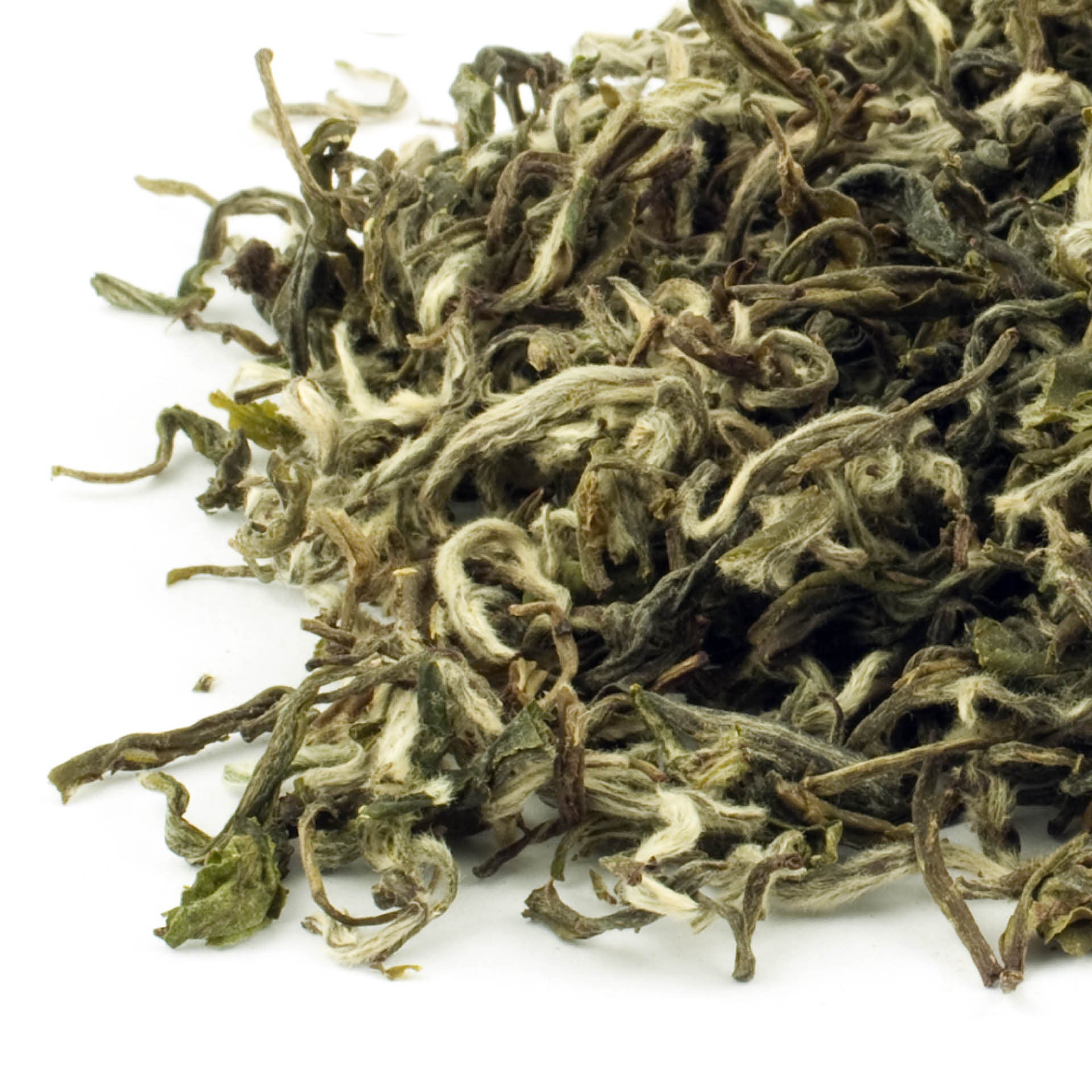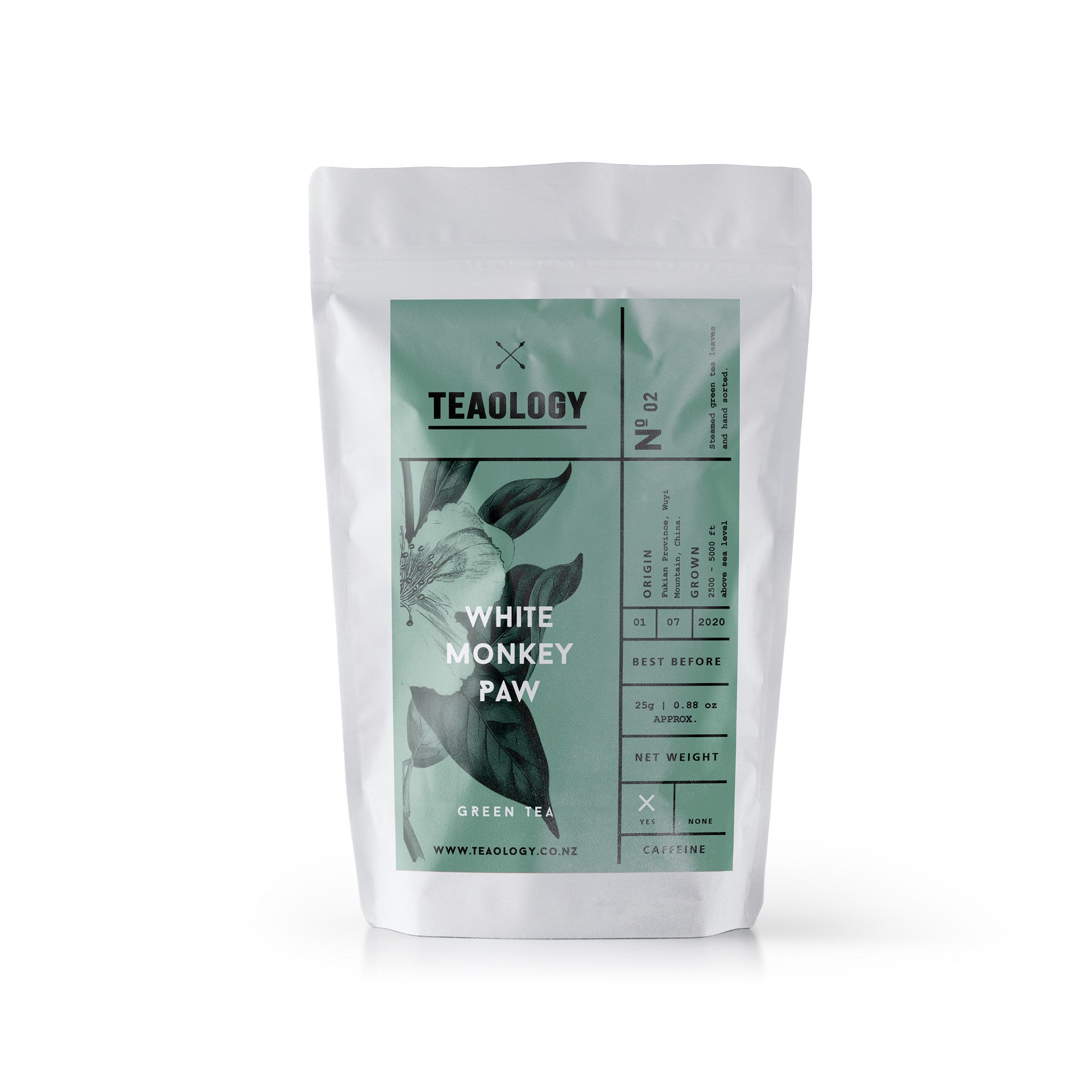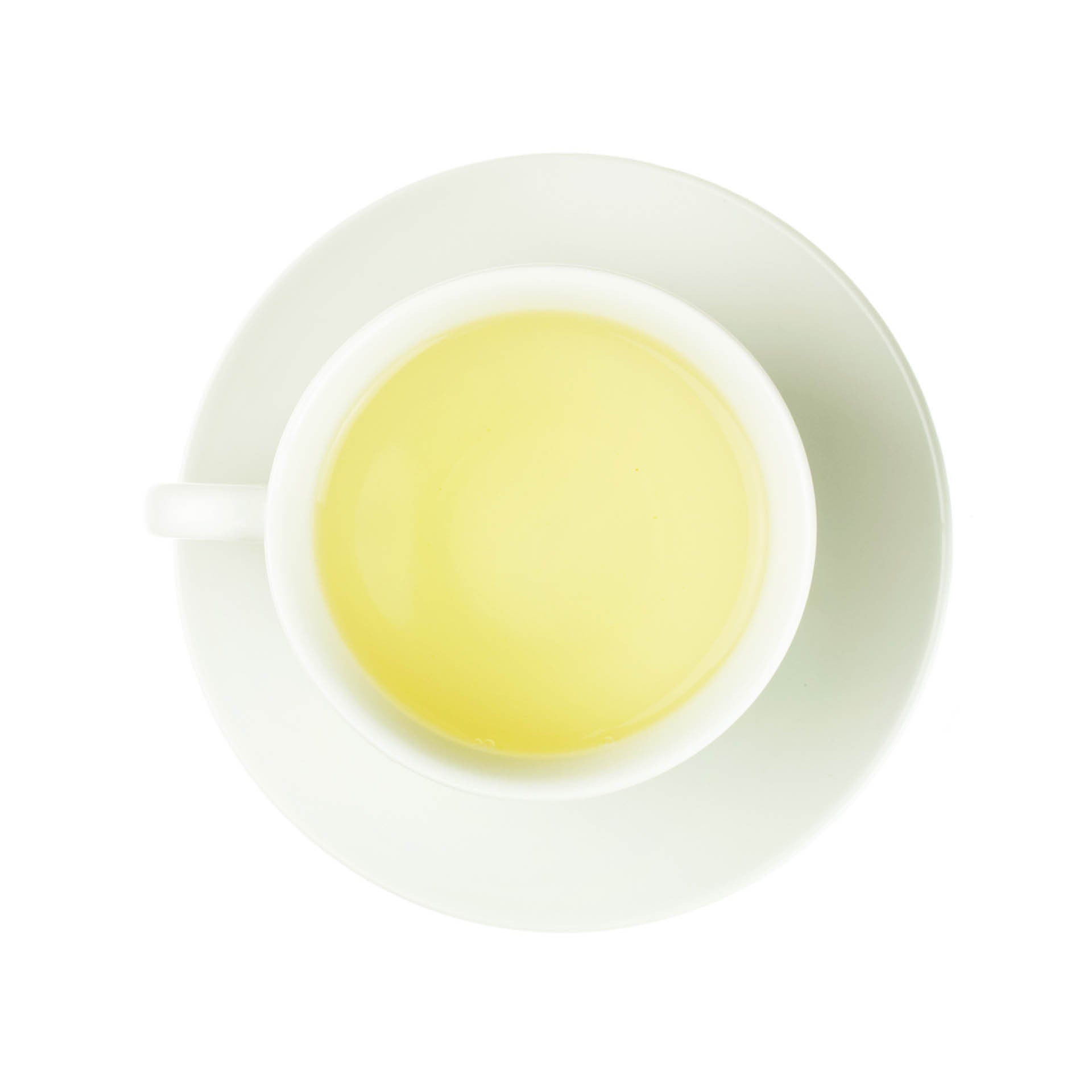White Monkey Paw
By Teaology
Early in the morning within the first two weeks of the new season’s growth, the top two leaves and bud are carefully plucked from the Camellia Sinensis or the more commonly known black tea bush. The tea leaves still have the ‘hairy down’ on them and when gently steamed and dried they become a truly superb green tea, known as White Monkey Paw. This tea gained its name as the dry leaf appearance is said to resemble a Monkey paw. Whilst it is a green tea, the infused liquor and visual appearance is so delicate it could almost be thought of as a white tea.
BREWING RECOMMENDATION
1-2 teaspoons per cup
INGREDIENTS
High-quality green tea
ORIGIN
Fukien province, Wuyi mountain, China
ALTITUDE
2500 - 5000 ft. above sea level
BAG 25 NET
Makes 15 - 30 standard cups of tea depending on personal strength of brew
TEA-SER VIAL
Makes 5 - 10 standard cups of tea depending on personal strength of brew
Health Benefits
-
Antioxidants in Tea
Antioxidants are chemicals that naturally help fight the harmful oxidation effects of unstable molecules in your body called free radicals that occurs naturally in the body when you are exposed to harmful environmental factors. Free radicals have extra electrons around them that bombard the molecules of cell membranes which leads to cell damage. Antioxidants take up these extra electrons so that your cells don’t have to. Free radicals may come from environmental contaminants such as radiation, pollution and exposure to toxins; but they also form as a result of normal bodily processes such as breathing oxygen.
There are three primary types of antioxidants found in nature. These include phytochemicals, vitamins, and enzymes. Although black tea has high levels of some essential antioxidant enzymes and vitamins such as Magnesium and Folate is it the Phytochemicals in tea that make them so powerful.
Antioxidant Phytochemicals
Phytochemicals are the antioxidants that are naturally used by plants to protect themselves against free radicals . Studies show that humans who eat sources of phytochemicals also benefit from the antioxidant properties of the plant. Phytochemicals are broken down into the following categories:• Carotenoids
• Flavonoids
• Allyl sulfides
• PolyphenolsMain flavonoids of a living tea leaf
Flavonoids are secondary metabolites (a group of naturally occurring biochemicals) that help a plant to grow strong and attain its various biological characters, such as its smell, colour or self-defense. The amount and varieties differ in different plants and in different parts and growing stages of a plant. The most predominant flavonoids in a growing young tea leaf are:Catechins in tea
• Catechin, Epigallocatechin (EGC)
• Epigallocatechin 3-gallate (EGCG)
• Epicatechin (EC)
• Epicatechin 3-gallate (ECg, or ECG, or EC3G)Catechins protect cell DNA. They are anti-mutagenic, anti-inflammatory and anti-pathogenic all delivered in a cup of tea.
Of all the catechins, EGCG, is a unique catechin in tea, has repeatedly demonstrated itself as the most potent health contributive factor in tea. It accounts for 50~75% of the catechins in green teas.Once a tea leaf is plucked, its flavonoids very slowly undergo a process of enzyme triggered oxidation that cause them, in particular the catechins, to transform into various substances, some are other forms of flavonoids, some yet other substances that may influence the taste and aroma of the final product. The production of various categories of tea is largely based on the control of this oxidation phenomenon. This oxidation of catechins is called “fermentation” in the tea production process.
Flavonols in tea
• Kaempferol
• Myricetin
• QuercetinKaempferol:
Acts as an antioxidant by reducing oxidative stress. Anti-inflammatory, antimicrobial, anticancer, cardioprotective, neuroprotective, antidiabetic, antiosteoporotic, estrogenic/antiestrogenic, anxiolytic, analgesic, and antiallergic activities. It has been linked with many sucessful anti-cancer treatments and and it is currently under consideration as a possible cancer treatment.Myricetin:
Myricetin works by disrupting cellular pathways. It interacts with enzymes and suppresses their activities (enzyme inhibition). Myricetin, is an anti-inflammatory, prevents blood clots, has many anti-cancer properties, increases glucose uptake thus helping manage diabetes, slows the progression of Alzheimers disease, protects the heart, controls fat deposition and helps prevent weight gain, anti-microbial, helps protect the skin against UV radiation and prevents skin wrinkles, protects eyesight and increases bone mass, Myricetin also increases iodine uptake as well as iodine retention by thyroid cells.Quercetin:
Inflammation is the root of most diseases, and Quercetin effectively fights anti-inflammatory related diseases such as: Atherosclerosis, circulation, high cholesterol, insulin resistance and diabetes, heart disease, eye-related disorders including cataracts, allergies, asthma and hayfever, stomach ulcers, cognitive impairment, gout, viral infections, inflammation of the prostrate, bladder and ovaries, chronic fatigue syndrome, cancer, chronic infections of the prostrate and skin disordersFlavones in tea
• Apigenin
• LuteolinApigenin:
Anti-inflammatory, antidepressant-like effects, anti-cancer properties, protects the heart, prevents bone loss, stimulates brain cell generation.Luteolin:
Luteolin interferes with nearly all types of cancer cells.
It inhibits the growth of new blood vessels in tumors, the metabolism of carcinogens, as well as stopping the progression of the cell cycle in cancer cells. Luteolin also induces cell death in cancer cells. Luteolin is also an anti-inflammatory, antioxidant, prevents UVB-induced skin aging, luteolin can be used in the prevention and treatment of cardiovascular diseases, protects the brain from neurological impairments, anti-viral properties, helps prevent cataracts, Luteolin has anti-oxidant and anti-inflammatory effects which can reduce the effects of multiple sclerosis, Luteolin has anti-oxidant and anti-inflammatory effects which can reduce the effects of multiple sclerosisFlavonoids in green tea
In the case of a fine green tea, the plucked leaf is withered very briefly for slight dehydration and then put through heat to halt the enzyme-triggered oxidation. The most original and quantity of flavonoids are thus kept. They can take up an average of 30% of the dry weight of the tea, dependent on the tea variety, pluck quality and harvest season. That means you have on average 300 mg of catechins and other flavonoids in each gram of tea leaves.Flavonoids in black tea
When the fresh leaves are taken to produce black tea, a large proportion of these flavonoids and catechins is oxidized to become other substances, mostly flavonoids of larger molecular structures, such as:• Theaflavins (TF)
• Thearubigins (TR)
• Theabrownins (TB)While most of medical researches on tea’s health potential focus around green tea catechins, in particular EGCG, there are a number done on theaflavins, finding that they may also be contributive to reduction of cardiovascular diseases and prevention of diabetes. Theaflavins contribute to the yellowish orange colour of the black tea infusion. They make up on average 6% of the black tea flavonoids.
Much fewer studies have been done on theabrownins, which are a lot more abundant in post-fermented teas, but with promising results on cholesterol control resulting in a reduced risk for heart disease. The antioxidants in green, black, and oolong teas can help block the oxidation of LDL (bad) cholesterol, increase HDL (good) cholesterol and improve artery function.
Drinking a cup of tea a few times a day helps to absorb antioxidants and other nutritional plant compounds. In green-tea drinking cultures, the usual amount is three cups per day. Allow tea to steep for three to five minutes to bring out its catechins. The best way to get the catechins and other flavonoids in tea is to drink it freshly picked and freshly brewed. Decaffeinated, bottled ready-to-drink tea (bag) preparations, and instant teas have less of these compounds.
Note that tea can impede the absorption of iron from fruits and vegetables. Adding lemon or milk or drinking tea between meals will counteract this problem.
-
Green Tea
Weight Loss
Green/white tea increases the metabolism. The polyphenol found in green/white tea works to intensify levels of fat oxidation and the rate at which your body turns food into calories.Diabetes
Green/white tea helps regulate glucose levels by slowing the rise of blood sugar after eating. This can prevent high insulin spikes and resulting fat storage.Heart Disease
Scientists think green/white tea works on the lining of blood vessels, helping keep them stay relaxed and better able to withstand changes in blood pressure. It may also protect against the formation of clots, which are the primary cause of heart attacks.Esophageal Cancer
It can reduce the risk of oesophagal cancer, but it is also widely thought to kill cancer cells in general without damaging the healthy tissue around them.Cholesterol
Green/white tea reduces bad cholesterol in the blood and improves the ratio of good cholesterol to bad cholesterol.Alzheimer’s and Parkinson’s
Current research sugggests that drinking Green/White tea delays the deterioration caused by Alzheimer’s and Parkinson’s disease. Studies carried out on mice showed that green/white tea protected brain cells from dying and restored damaged brain cells.Tooth Decay
Studies suggest that the chemical antioxidant 'catechin' in tea can destroy bacteria and viruses that cause throat infections, dental cavities and other dental conditions.Blood Pressure
Regular consumption of green/white tea is thought to reduce the risk of high blood pressure.Depression
Theanine is an amino acid naturally found in tea leaves. It is this substance that is thought to provide a relaxing and tranquillizing effect and be a great benefit to tea drinkers.Anti-viral and Anti-bacterial
Tea catechins are strong antibacterial and antiviral agents which make them effective for treating everything from influenza to cancer. In some studies, green/white tea has been shown to inhibit the spread of many diseases.Skincare
Green and white tea also helps with wrinkles and premature ageing, This is because of the high levels of antioxidant and anti-inflammatory activities. Both animal and human studies have demonstrated that green tea applied topically can also reduce sun damage.




